Shoes
THE NORTH FACE – ULTRA MT GORE-TEX®
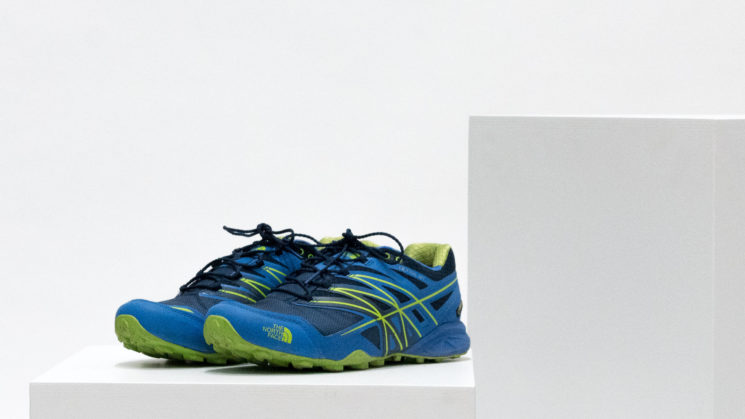
When you think running, The North Face might not be the first brand that pops into you head. But when you think winter running, it definitely should be.
The North Face MT GTX running shoes are built to handle just about any terrain that you’ll encounter during a winter run. From rainy streets to snow covered trails to a vertical ascent up the side of a building (not advised), these shoes are built with traction in mind. Sturdy yet slightly heavy, it’s exactly the kind of shoe you need to keep you running through those cold winter months.
The Good:
Vibram® Megagrip traction means you’re stable on even the slipperiest surfaces.
Keep your feet warm in even the coldest conditions.
Waterproof Goretex® membrane keeps your feet dry no matter the weather.
Despite its well-built design, this shoe is still light enough that it won’t slow you down.
The Bad:
Laces are a bit waxy, but I’m honestly reaching here.
The Verdict:
I’ve never had a shoe that felt like it was truly designed for winter running, but The North Face has shown me the light. It’s the fastest I’ve ever been on ice and snow, without worrying about slipping and crashing. I can’t recommend these shoes enough.
Rating: 5/5
SKECHERS – GOTRAIL
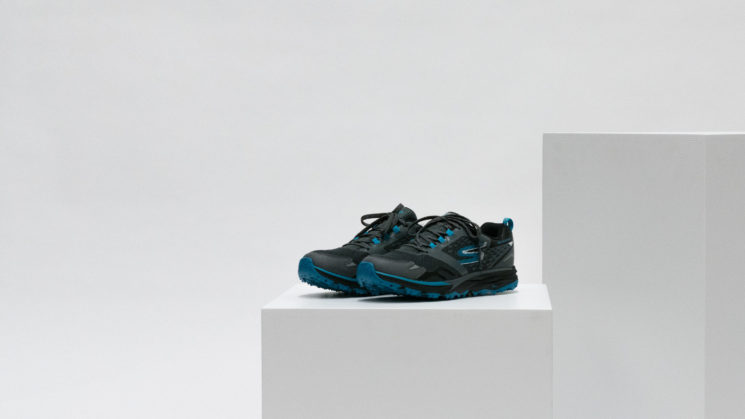
I tested the Skechers GoTrail Adventure Shoe over 50km in a variety of conditions. The time of year, and varied city terrain allowed me to run in several weather conditions on runs both long and short. I usually run in a stability shoe with a little more cushion around the arch due to high arches and underpronation, so I was looking forward to stress-testing these shoes.
The trail-ready stability and cushioned midsole should have answered my (often heel numbing) need for a little extra support and padding, but the sloped heel ended up causing additional pressure on my arch, leading to a little discomfort during the run when on flat and dry roads.
I do think it’s worth mentioning that when running hilly trails, the additional traction made my stride more effective, and where the sloped heel was detrimental to a flat road run, it actually made running downhill much easier. The GoTrail’s grip also gave me the confidence to maintain my pace while running downhill in icier conditions.
The Good:
Stable and padded – good for runners with high arches and underpronation.
Sloped heel makes for a more effective strike when running downhill.
Good traction in snowy or wet weather.
Waterproof.
The Bad:
Sloped heel makes running on flat terrain uncomfortable.
Not the sexiest shoe on the market.
A little too firm.
The Verdict:
What this shoe lacked in design, it made up for in performance on snow covered hills. The limited flex caused a little more post run strain on feet and knees after running on flat surfaces, but also contributed to an overall positive experience on trails. It is a useful to have in my winter arsenal, but will likely serve a very specific purpose on the snowiest of days.
Rating: 3.5/5
BROOKS – CASCADIA 11 GTX TRAIL-RUNNING SHOES
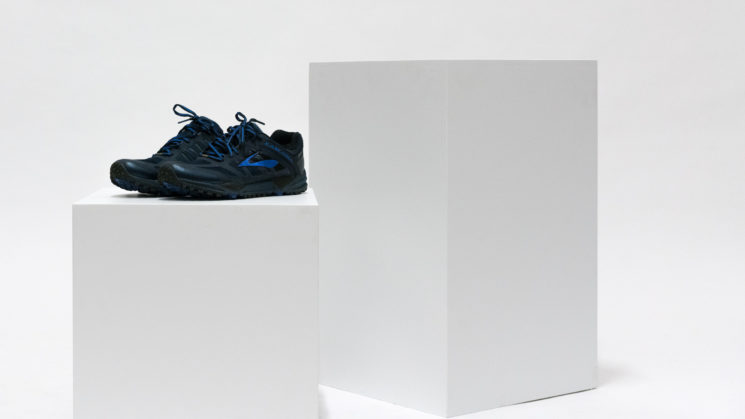
This year skip those slip-on grips. The Brooks Cascadia 11 GTX might be the only shoe you wear this winter, on and off trail.
The Good:
Goretex® waterproofing keeps your feet warm and dry without that swampy-foot feeling.
The trail-inspired on is well balanced to offer an equilibrium of grip on snow and cushioning for both trail and road runs.
Laces are textured to help keep them tight on the run.
Great colorway. Many trail shoes look like they lost a fight with a box of crayons, these will blend in nicely to your kit or your après-run.
The Bad:
Low profile fit around the ankle might make you nervous when you first put them on.
They could use a hit of reflective material for nighttime road running.
The Verdict:
Very surprised by this shoe. Brooks is known for making a shoe for runners but to have something speak to both aesthetics and function so well is rare from an endemic brand. Every runner will have to judge the comfort of the shoe to their foot. However, Brooks has done everything right with this silhouette.
Rating: 4.5/5
NIKE – AIR ZOOM PEGASUS 33 SHIELD
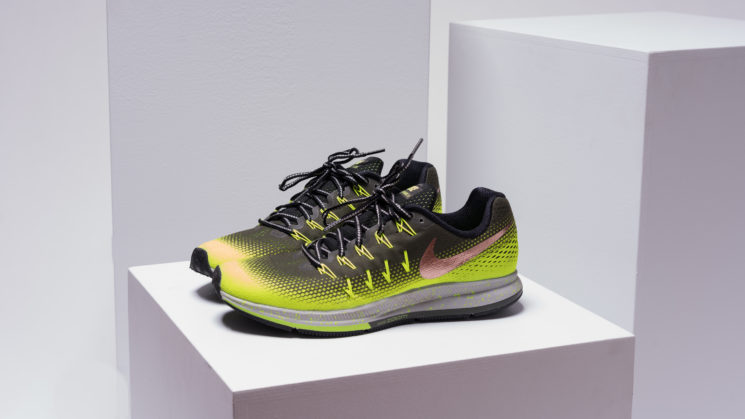
Take your favorite running shoe, then winterize it with a water-repellent coating, reflective detailing and non-slip laces. That’s the Nike Air Zoom Pegasus 33 Shield. It’s not Goretex®, but not everything needs to be.
The Good:
Weatherized for most winter running conditions.
Lightweight, very responsive shoe.
Great colorways because aesthetics do count for something.
The Bad:
Not featuring Goretex® means it’s not as warm as some competitor offerings.
The ‘sticky rubber’ doesn’t perform as well as winter-specific, deeper tread patterns do.
The Verdict:
I don’t believe that you need a Goretex® boot for winter running, so it’s not a drawback in my eyes, especially for any runs under an hour. I love how light the shoes feel and the responsiveness, even in contrast to other Nike models. The laces are great, adding reflectivity and the grippy laces means less stopping to tighten/re-tying laces which is a big win.
Rating: 4/5
BROOKS – ADRENALINE GTS 17
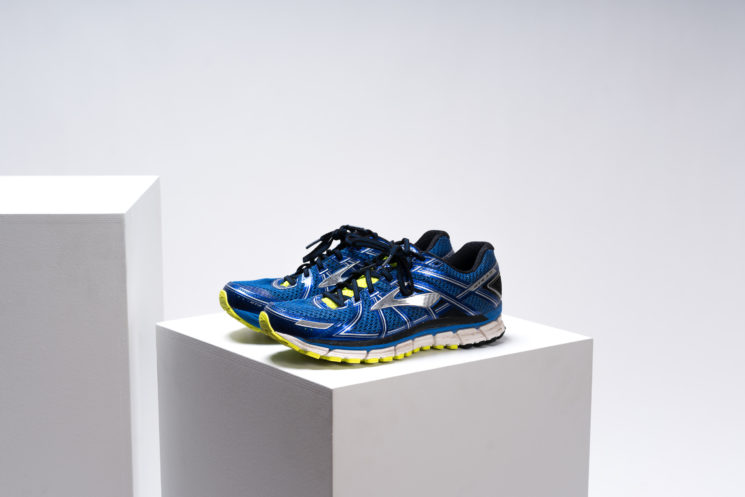
Every so often a shoe comes along that inspires a runner to push the limits of what they responsibly know; a Cinderella moment, of sorts, where from the moment their heel connects with the inner sole, a bond between runner and shoe is formed.
The Brooks Adrenaline GTS 17 could be that shoe, but everything it delivers in comfort and performance, it lacks in design.
The Good:
Incredible stability and comfort.
Great on road, snow, and trail.
The Bad:
A little heavier than other shoes in its class.
Weak colour combinations.
The Verdict:
Why companies feel like they need to sacrifice style for performance is something I will never understand. These shoes would have my highest praise if not for the reduced colour palette selection. I would highly recommend this nearly flawless shoe, but I would also highly recommend a change in how Brooks dresses them up.
Rating: 4.75/5
NIKE – AIR ZOOM STRUCTURE 20
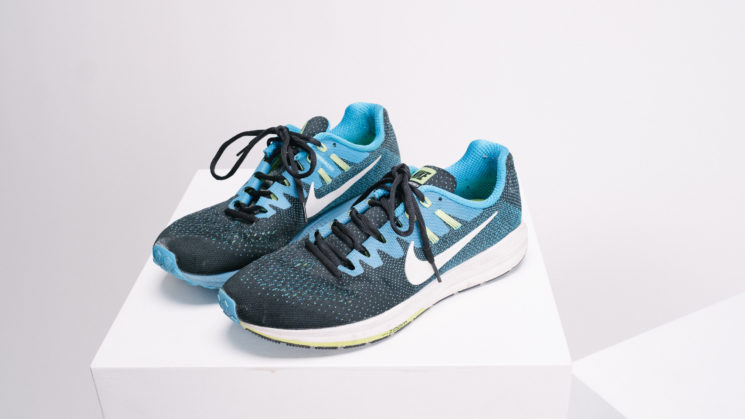
As avid runners and newbies alike can attest to new shoes take some getting used to. The break in period, so to speak. Although I’m accustomed to running in Nike’s, I found the Nike Air Zoom Structure 20 required a lengthier acclimatization timeframe. It was around my 35th kilometer when I could truly enjoy their tech and structural properties.
The Zoom Structures 20 provide a stability that delivers a sense of confidence, allowing you to change city terrains with ease. This brings us to the question can they handle urban running in the winter? YES.
The Good:
The inner sleeve and straps make for a secure midfoot fit.
You can pound them on pavement and still feel like you’re flying.
The forefoot cushioning exceeded what I expected in responsiveness giving you traction you trust out in the cold.
The Bad:
No waterproofing – If you want to hit some trails with the these go with the Shield version. The added weather resistant properties will have you crushing light trails.
The Verdict:
These are a great shoe to have in your weekly training rotation especially your longer runs. Moral of the story give the structures some time before passing judgement or you might miss out on a great shoe!
Rating: 4/5
ADIDAS – TERREX AGRAVIC GTX
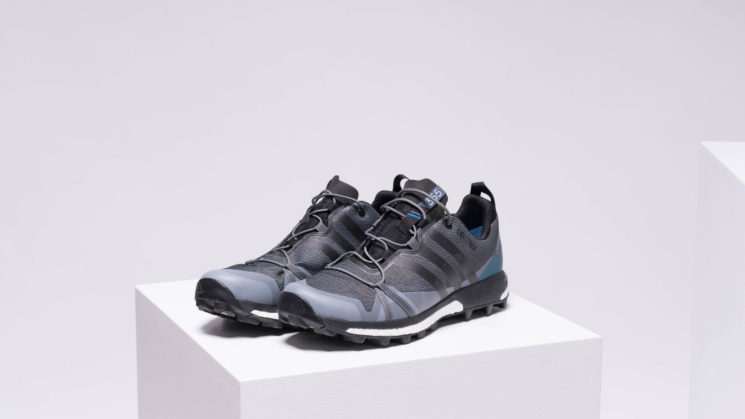
Winter is a tricky beast, and that can make choosing just one go-to shoe that much harder. What works for some, doesn’t always work for others. This statement can be true in many facets of life, but in this case, I’m referring to the adidas Terrex Agravic GTX shoes. It seems to be that when I tested these shoes, many of my positive aspects happen to be negatives as well, the untimely downfall of winter running shoes. Weather and conditions variability.
Being completely water resistant and breathable are the ultimate factors when it comes to picking your winter shoe and the Terrex Agravic GTX’s excel in their Goretex® construction. The only downfall is that it’s deep grooved cleated sole makes it harder to run when the pavement is dry or icy.
The Good:
Fully waterproof – Goretex® construction.
Cleated soles – This is both a plus and minus depending on your setting.They are super grippy on anything but concrete or straight ice.
Trail style lacing system.
Rigid construction, this may not be a plus for some, but I look for a structured ankle/heel support in running shoes.
The Bad:
Zero reflective features.
Deep grooved cleated soles make it uncomfortable to run on pavement.
The laces are slippery due to waterproofing, making them prone to come undone quite often.
The Verdict:
The Terrex Agravic GTX are very close to being the perfect winter running shoe. I greatly appreciate their rigid construction that focuses on ankle and heel support. You can rest assured your feet will be dry and warm throughout the season, but note that they that they are ideal for snow covered streets and trails.
Rating: 4/5
BROOKS – GHOST 9 GTX
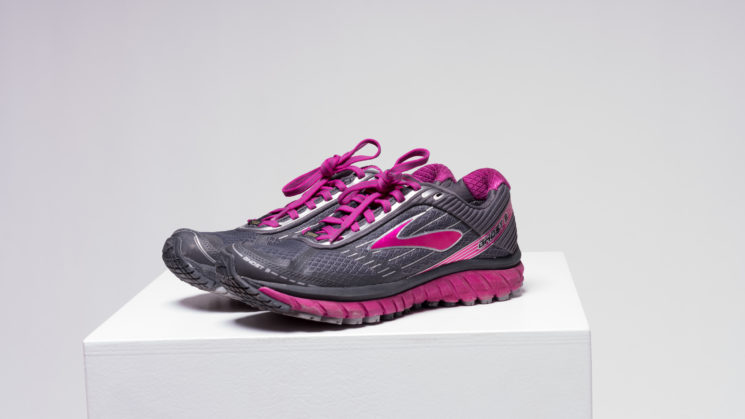
These shoes have changed my perception of outdoor running. There’s no better feeling that getting in from a run and kicking off your shoes to find your socks and feet dry and warm. Even before that, my initial reaction was I LOVE THEM. Can I scream it from a mountain top?!
These shoes felt like they were made specifically for me. Bespoke for my feet only from the first moment I slipped them on. As most runners know, a break-in period can tend to be quite painful and a bit of an adjustment, therefore I was pleasantly surprised when they felt great from day one.
The Good:
No break in period.
Insane level of comfort.
Excellent control from pavement to trail in snow or slippery conditions.
Waterproofing will let you run through snow, slush, rain, puddles, mud, you name it, they can take it.
High tongue – sealing in your foot from the elements.
The Bad:
Lacks reflectivity, only a small patch on the heel.
The Verdict:
Not only are they warm and waterproof but they feel like butter. Need I say more? Go get a pair.
Rating: 5/5
THE NORTH FACE - ULTRA MT GORE-TEX®

When you think running, The North Face might not be the first brand that pops into you head. But when you think winter running, it definitely should be.
The North Face MT GTX running shoes are built to handle just about any terrain that you’ll encounter during a winter run. From rainy streets to snow covered trails to a vertical ascent up the side of a building (not advised), these shoes are built with traction in mind. Sturdy yet slightly heavy, it’s exactly the kind of shoe you need to keep you running through those cold winter months.
The Good:
Vibram® Megagrip traction means you’re stable on even the slipperiest surfaces.
Keep your feet warm in even the coldest conditions.
Waterproof Goretex® membrane keeps your feet dry no matter the weather.
Despite its well-built design, this shoe is still light enough that it won’t slow you down.
The Bad:
Laces are a bit waxy, but I’m honestly reaching here.
The Verdict:
I’ve never had a shoe that felt like it was truly designed for winter running, but The North Face has shown me the light. It’s the fastest I’ve ever been on ice and snow, without worrying about slipping and crashing. I can’t recommend these shoes enough.
Rating: 5/5
SKECHERS - GOTRAIL

I tested the Skechers GoTrail Adventure Shoe over 50km in a variety of conditions. The time of year, and varied city terrain allowed me to run in several weather conditions on runs both long and short. I usually run in a stability shoe with a little more cushion around the arch due to high arches and underpronation, so I was looking forward to stress-testing these shoes.
The trail-ready stability and cushioned midsole should have answered my (often heel numbing) need for a little extra support and padding, but the sloped heel ended up causing additional pressure on my arch, leading to a little discomfort during the run when on flat and dry roads.
I do think it's worth mentioning that when running hilly trails, the additional traction made my stride more effective, and where the sloped heel was detrimental to a flat road run, it actually made running downhill much easier. The GoTrail’s grip also gave me the confidence to maintain my pace while running downhill in icier conditions.
The Good:
Stable and padded - good for runners with high arches and underpronation.
Sloped heel makes for a more effective strike when running downhill.
Good traction in snowy or wet weather.
Waterproof.
The Bad:
Sloped heel makes running on flat terrain uncomfortable.
Not the sexiest shoe on the market.
A little too firm.
The Verdict:
What this shoe lacked in design, it made up for in performance on snow covered hills. The limited flex caused a little more post run strain on feet and knees after running on flat surfaces, but also contributed to an overall positive experience on trails. It is a useful to have in my winter arsenal, but will likely serve a very specific purpose on the snowiest of days.
Rating: 3.5/5
BROOKS - CASCADIA 11 GTX TRAIL-RUNNING SHOES

This year skip those slip-on grips. The Brooks Cascadia 11 GTX might be the only shoe you wear this winter, on and off trail.
The Good:
Goretex® waterproofing keeps your feet warm and dry without that swampy-foot feeling.
The trail-inspired on is well balanced to offer an equilibrium of grip on snow and cushioning for both trail and road runs.
Laces are textured to help keep them tight on the run.
Great colorway. Many trail shoes look like they lost a fight with a box of crayons, these will blend in nicely to your kit or your après-run.
The Bad:
Low profile fit around the ankle might make you nervous when you first put them on.
They could use a hit of reflective material for nighttime road running.
The Verdict:
Very surprised by this shoe. Brooks is known for making a shoe for runners but to have something speak to both aesthetics and function so well is rare from an endemic brand. Every runner will have to judge the comfort of the shoe to their foot. However, Brooks has done everything right with this silhouette.
Rating: 4.5/5
NIKE - AIR ZOOM PEGASUS 33 SHIELD

Take your favorite running shoe, then winterize it with a water-repellent coating, reflective detailing and non-slip laces. That’s the Nike Air Zoom Pegasus 33 Shield. It’s not Goretex®, but not everything needs to be.
The Good:
Weatherized for most winter running conditions.
Lightweight, very responsive shoe.
Great colorways because aesthetics do count for something.
The Bad:
Not featuring Goretex® means it’s not as warm as some competitor offerings.
The ‘sticky rubber’ doesn’t perform as well as winter-specific, deeper tread patterns do.
The Verdict:
I don’t believe that you need a Goretex® boot for winter running, so it’s not a drawback in my eyes, especially for any runs under an hour. I love how light the shoes feel and the responsiveness, even in contrast to other Nike models. The laces are great, adding reflectivity and the grippy laces means less stopping to tighten/re-tying laces which is a big win.
Rating: 4/5
BROOKS - ADRENALINE GTS 17

Every so often a shoe comes along that inspires a runner to push the limits of what they responsibly know; a Cinderella moment, of sorts, where from the moment their heel connects with the inner sole, a bond between runner and shoe is formed.
The Brooks Adrenaline GTS 17 could be that shoe, but everything it delivers in comfort and performance, it lacks in design.
The Good:
Incredible stability and comfort.
Great on road, snow, and trail.
The Bad:
A little heavier than other shoes in its class.
Weak colour combinations.
The Verdict:
Why companies feel like they need to sacrifice style for performance is something I will never understand. These shoes would have my highest praise if not for the reduced colour palette selection. I would highly recommend this nearly flawless shoe, but I would also highly recommend a change in how Brooks dresses them up.
Rating: 4.75/5
NIKE - AIR ZOOM STRUCTURE 20

As avid runners and newbies alike can attest to new shoes take some getting used to. The break in period, so to speak. Although I’m accustomed to running in Nike’s, I found the Nike Air Zoom Structure 20 required a lengthier acclimatization timeframe. It was around my 35th kilometer when I could truly enjoy their tech and structural properties.
The Zoom Structures 20 provide a stability that delivers a sense of confidence, allowing you to change city terrains with ease. This brings us to the question can they handle urban running in the winter? YES.
The Good:
The inner sleeve and straps make for a secure midfoot fit.
You can pound them on pavement and still feel like you’re flying.
The forefoot cushioning exceeded what I expected in responsiveness giving you traction you trust out in the cold.
The Bad:
No waterproofing - If you want to hit some trails with the these go with the Shield version. The added weather resistant properties will have you crushing light trails.
The Verdict:
These are a great shoe to have in your weekly training rotation especially your longer runs. Moral of the story give the structures some time before passing judgement or you might miss out on a great shoe!
Rating: 4/5
ADIDAS - TERREX AGRAVIC GTX

Winter is a tricky beast, and that can make choosing just one go-to shoe that much harder. What works for some, doesn’t always work for others. This statement can be true in many facets of life, but in this case, I’m referring to the adidas Terrex Agravic GTX shoes. It seems to be that when I tested these shoes, many of my positive aspects happen to be negatives as well, the untimely downfall of winter running shoes. Weather and conditions variability.
Being completely water resistant and breathable are the ultimate factors when it comes to picking your winter shoe and the Terrex Agravic GTX’s excel in their Goretex® construction. The only downfall is that it’s deep grooved cleated sole makes it harder to run when the pavement is dry or icy.
The Good:
Fully waterproof - Goretex® construction.
Cleated soles - This is both a plus and minus depending on your setting.They are super grippy on anything but concrete or straight ice.
Trail style lacing system.
Rigid construction, this may not be a plus for some, but I look for a structured ankle/heel support in running shoes.
The Bad:
Zero reflective features.
Deep grooved cleated soles make it uncomfortable to run on pavement.
The laces are slippery due to waterproofing, making them prone to come undone quite often.
The Verdict:
The Terrex Agravic GTX are very close to being the perfect winter running shoe. I greatly appreciate their rigid construction that focuses on ankle and heel support. You can rest assured your feet will be dry and warm throughout the season, but note that they that they are ideal for snow covered streets and trails.
Rating: 4/5
BROOKS - GHOST 9 GTX

These shoes have changed my perception of outdoor running. There’s no better feeling that getting in from a run and kicking off your shoes to find your socks and feet dry and warm. Even before that, my initial reaction was I LOVE THEM. Can I scream it from a mountain top?!
These shoes felt like they were made specifically for me. Bespoke for my feet only from the first moment I slipped them on. As most runners know, a break-in period can tend to be quite painful and a bit of an adjustment, therefore I was pleasantly surprised when they felt great from day one.
The Good:
No break in period.
Insane level of comfort.
Excellent control from pavement to trail in snow or slippery conditions.
Waterproofing will let you run through snow, slush, rain, puddles, mud, you name it, they can take it.
High tongue - sealing in your foot from the elements.
The Bad:
Lacks reflectivity, only a small patch on the heel.
The Verdict:
Not only are they warm and waterproof but they feel like butter. Need I say more? Go get a pair.
Rating: 5/5
